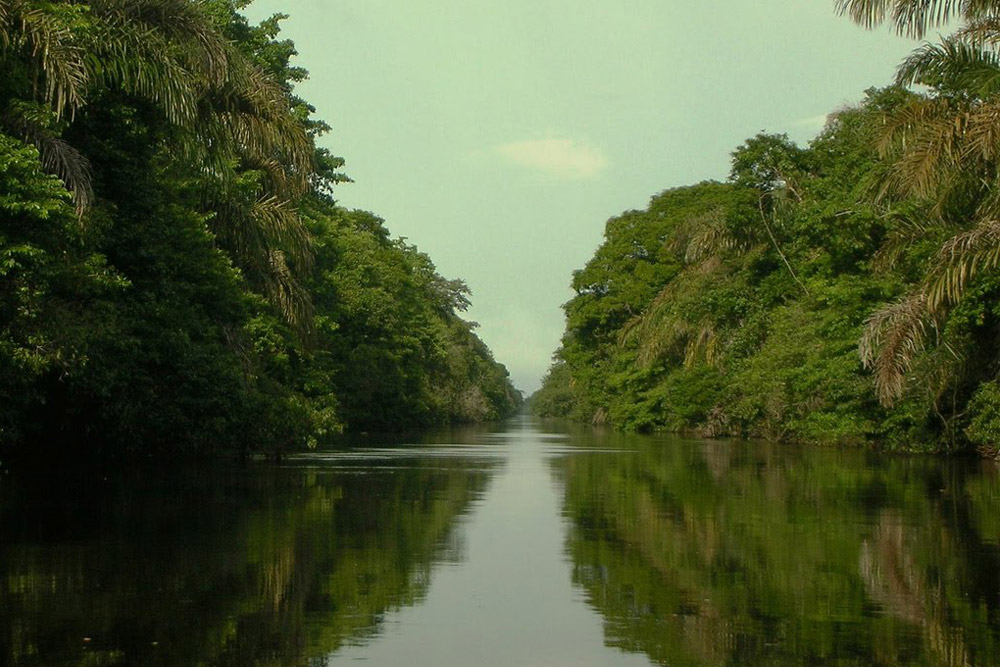
The National Park Tortuguero is on the coast of the Carib, province of Limon, approximately 80km to the North-East of the city of the same name.
It was established by means of the Law Not. 5680 of November 17, 1975. It is provided with an area of 18.946.9 hectares in the terrestrial and part 52.265 in the marine part.
It is the most important area of the whole western half of the Carib, for the spawning of the green turtle. Other species of marine turtles that also spawn in the beach are the turtle baula and the tortoiseshell.
The park is crossed by a natural sitema of lagoons and navigable channels of big scenic beauty and they are the habitat of species of terrestrial turtles, of the sea cow or marine cow, of the crocodile, of big diversity of crustaceans and of approximately 52 species of fish of fresh water, including the fish gaspar.
It was created to protect the flora and fauna of this region, as well as to facilitate investigations, scientific studies and to propitiate the environmental education.
Three zones of life exist: very humid tropical forest, premountainous humid forest transition to basal and the tropical humid forest.It includes eight types of major affiliations (trees, shrubs and grasses) and three minor affiliations (grasses in most cases).
The coastal vegetation with predominance of gramíneas, the humid forest with plenty of strata and vertical, sotobosque dense and varied characterized by ferns, the white palm and several species of anonáceas, forests on hillocks, the yolillales, constituted principally by the palm yolillo and located in the central sector of the park, herbaceous marshes formed by herbaceous plants of haste 2 meters high and communities herbaceous on lagoons with floating vegetation as the choreja or water iris; they are some of the most outstanding vegetable affiliations of the park.
Tortuguero is one of the most rainy zones of the country, between 5.000 and 6.000 mm a year. Two types of rain can differ: the local downpours of short duration that are the most frequent, and the characteristic storms of the Carib that extend up to 15 days.The above mentioned are caused by the winds by trade winds of the north and northwest.
The species of flora more characteristics are: the cedar male, the sparrow-hawk, the basin, the black javillo, the golden fruit, the manú, maría, the camphor, the canfín, the cativo, the palm yolillo, the palm suita, the real palm and the choreja or water iris. The choreja forms sometimes masses so compact that they can prevent the navigation.
The fauna is rich and diverse.Between the most outstanding we find the danta, the jaguar, the manigordo, the peccary, the monkey congo, the monkey carablanca, the colored monkey or it scratches, the lazy one, the tepescuinte, the pizote, the raccoon, hammers it, the otter, the tolomuco, the bat fisherman who is one of the biggest of the country and feeds of fish that it captures with his fortresses paws and fingernails when it flies over on the surface of the water; the frog calf, the glass frog reticulada whose internal organs are seen across his transparent skin; the poisonous frog or sapito red, whose skin is poisonous.
Some of the protected birds are the green limpet, species in danger of extinction, the peacock, the zopilote cabecirrojo, the sparrow-hawk crab catcher, the violet trogón and the golden oriole of montezuma. Also, of the turtle baula, the tortoiseshell and the green turtle; the turtle jicotea black, it is very common in the channels from Moín up to Tortuguero.

 English
English






